Как выбирают геймерский ноутбук?
Каждый геймер, выбирая ноутбук, задается вопросом: на что стоит обратить внимание? Некоторые идут за объемом памяти, другие за видеокартой, но профи знают: сердцем машины является процессор. Давайте разберемся, на что он влияет и как делать правильный выбор!. Процессор — это, по сути, мозг вашего компьютера
От его мощности зависит, насколько быстро будут выполняться все команды, включая загрузку игр, графическую обработку и даже ваше общение с командой в чате. К тому же, геймеры не просто играют, они еще стримят, записывают свои игры, общаются в дискорде, слушают музыку и делают еще кучу вещей одновременно. И именно мощный процессор позволяет делать все это без лагов и зависаний
Процессор — это, по сути, мозг вашего компьютера. От его мощности зависит, насколько быстро будут выполняться все команды, включая загрузку игр, графическую обработку и даже ваше общение с командой в чате. К тому же, геймеры не просто играют, они еще стримят, записывают свои игры, общаются в дискорде, слушают музыку и делают еще кучу вещей одновременно. И именно мощный процессор позволяет делать все это без лагов и зависаний.
Итак, на что же что обращать внимание если требуется мощный комп или ноут?
- Количество ядер процессора: Больше ядер — больше задач можно обрабатывать одновременно.
- Частота процессора: Определяет, насколько быстро процессор может обрабатывать информацию.
- Тепловыделение: Важный параметр, чтобы понять, не будет ли он перегреваться.
- Серия процессора: чем она новее, тем мощнее будет процессор, а значит будет актуальным еще лет 5.
И раз уж мы затронули эту тему расскажем про роль процессора в игровом ноутбуке.
Пример характеристик ноутбука, когда процессор выдаёт максимальную производительность:

● Процессор: AMD Ryzen 7 7840HS 8 x 3.8
● Видеокарта: NVIDIA GeForce RTX 4060 Laptop GPU — 8 Гбайт
● Дисплей: 16 дюймов; 2560 x 1600 пикс
● Тип матрицы: IPS
● Частота обновления: 165 Гц
● Веб-камера: 1920 x 1080
● ОЗУ: 16 Гбайт, DDR5-5600
Перфоманс
Ни Asus, ни AMD не показали тестов и не рекламировали конкретные параметры, когда речь идет о производительности чипов серии Z1. Дисплей Full HD 120 Гц, что дает нам представление об уровне производительности, к которому мы стремимся.
На данный момент мы можем делать только расплывчатые выводы относительно производительности Z1 по сравнению с Z1 Extreme на основе спецификаций. Мы ожидаем, что разрыв в производительности будет довольно большим, учитывая разницу в количестве ядер и потоков, а также огромный разрыв между графическими вычислительными блоками (2 против 6). Однако оба чипа серии Ryzen Z1 основаны на одной архитектуре, так что разницы между поколениями не будет. Спецификации обоих чипов предполагают, что какой бы из них вы ни выбрали, производительность должна превышать производительность Steam Deck.
Оба чипа будут поддерживаться интеллектуальным охлаждением Asus ROG Intelligent Cooling. Вы найдете то, что Asus называет термальной системой Zero Gravity, цель которой — хорошо охладить устройство, независимо от того, как вы его держите. Есть также антигравитационные тепловые трубки Asus, обеспечивающие попадание воды туда, куда нужно.
На борту есть два вентилятора, и Asus продемонстрировала преимущества этого во время пресс-конференции, продемонстрировав заметно более холодную заднюю часть устройства, а также меньший шум, чем решение с одним вентилятором.
Серия AMD Ryzen Z1: характеристики и особенности
Что касается спецификаций, AMD Ryzen Z1 оснащен шестью процессорными ядрами Zen 4, что в общей сложности обеспечивает 12 логических потоков, которые работают с заявленной базовой тактовой частотой 3,2 ГГц и максимальным ускорением. часы 4,9 ГГц. Пользовательская SoC включает в себя более скромный iGPU RDNA 3, в частности Radeon 740M, с четырьмя вычислительными блоками (256 шейдеров), работающими в диапазоне частот ядра 1,5 ГГц-2,5 ГГц.
Между тем, Ryzen Z1 Extreme имеет восьмиядерную/16-поточную компоновку с базовой частотой 3,3 ГГц и частотой повышения до 5,1 ГГц. Помимо поднятия Количество ядер/потоков и тактовая частота, вариант Extreme также оснащен более мощным Radeon 780M на базе RDNA 3 с 12 вычислительными блоками (768 шейдеров) с тактовой частотой около 1,5 ГГц-2,7 ГГц.
Несмотря на то, что оба APU остаются идентичными в своем настраиваемом диапазоне TDP от 9 Вт до 30 Вт, Ryzen Z1 Extreme выигрывает от немного большего размера кэш-памяти, чем у стандартного чипа Z1. Благодаря включению двух дополнительных ядер вариант Extreme использует 24 МБ комбинированного кэша (L2 + L3), тогда как Ryzen Z1 использует общий размер кэша 22 МБ.
Как и процессоры потребительского класса AMD от Серия Райзен 7000, ванильный Ryzen Z1 и его аналог Extreme предлагают встроенную поддержку двухканальных контроллеров памяти LPDDR5-5600/LPDDR5X-7500
Учитывая, насколько важно для APU полагаться на системную память с высокой пропускной способностью, оба варианта должны обеспечивать повышенную производительность и меньшую задержку в подавляющем большинстве игр AAA
Переходя на уровень платформы, APU AMD Ryzen серии Z1 поддерживают новейший интерфейс USB 4.0, что позволяет гораздо более высокая скорость передачи данных (до 40 Гбит/с) и простота подключения внешних устройств хранения и отображения. Кроме того, с помощью программного обеспечения AMD: Adrenalin Edition можно улучшить игровой процесс, используя проприетарные технологии, такие как Radeon Super Resolution, Radeon Chill, Radeon Anti-Lag, Radeon Boost и AMD Связь.
|
Технические характеристики |
AMD Райзен Z1 |
AMD Райзен Z1 Экстрим |
|---|---|---|
|
Платформа |
Портативный |
Портативный |
|
Архитектура |
Zen4/RDNA 3 |
Дзен 4/РДНК 3 |
|
Узел процесса |
TSMC N4 (4 нм) |
TSMC N4 (4 нм) |
|
Ядра/потоки |
6/12 |
8/16 |
|
Базовые часы |
3,2 ГГц |
3,3 ГГц |
|
Повышение тактовой частоты |
4,9 ГГц |
5,1 ГГц |
|
Кэш L1 |
512 КБ |
512 КБ |
|
Кэш L2 |
6 МБ |
8 МБ |
|
Кэш L3 |
16 МБ |
16 МБ |
|
cTDP |
9Вт-30Вт |
9Вт-30Вт |
|
Вычислительные блоки графического процессора |
4 |
12 |
|
Тактовая частота графического процессора |
До 2,5 ГГц |
До 2,7 ГГц |
|
Производительность FP32 (одинарная точность) |
2,8 терафлопс |
8,6 терафлопс |
|
Поддержка памяти |
LPDDR5-5600/LPDDR5X-7500 |
LPDDR5-5600/LPDDR5X-7500 |
|
Дата запуска |
04/25/2023 |
04/25/2023 |
Если мы внимательно посмотрим на основные характеристики обоих APU, станет очевидно, что Ryzen Z1 и Z1 Extreme имеет поразительное сходство с парой грядущих чипов AMD Ryzen серии 7040U для ультрапортативных устройств. ноутбуки. Энтузиасты кремния отметили, что стандартный Ryzen Z1 тесно связан с AMD Ryzen 5 7540U среднего уровня, тогда как вариант Extreme находится рядом с Ryzen 7 7840U высшего уровня.
В ответ на эти запросы AMD пояснила, что, хотя APU Ryzen серии Z1 придерживаются той же аппаратной конфигурации, что и Ryzen 7 7840U/Ryzen 5 7540U, они были специально созданы для удовлетворения уникальных требований портативных игровых устройств в разум. В результате группе инженеров пришлось утвердить совершенно новый профиль мощности с дальнейшей оптимизацией для поддержания правильных кривых напряжения.
По сравнению с линейкой Ryzen 7040U, которая ограничена ограничительным диапазоном TDP 15-30 Вт, AMD Ryzen Z1 APU Series могут потреблять всего 9 Вт в менее требовательных сценариях или до 30 Вт в интенсивном режиме. рабочие нагрузки. В дополнение к этим корректировкам движок XDNA AI от Team Red также был отключен (не удален на аппаратном уровне) на Ryzen Z1 и Z1 Extreme, что позволило снизить производственные затраты.
The heart of the Ally
 Jacob Roach / Digital Trends
Jacob Roach / Digital Trends
Let’s focus a bit more on the heart of the ROG Ally, though: the Ryzen Z1 Extreme APU. It comes with eight Zen 4 cores and 12 RDNA 3 graphics cores, with theoretical performance of 8.6 TFLOPs. For context, the PS5 has a theoretical performance of 10.3 TFLOPs.
You’re not getting PS5 levels of performance in the ROG Ally, but it’s a good illustration of the performance on tap. The main limiting factor is power. The Ryzen Z1 Extreme can operate in a range of 9 watts to 30W of sustained power (it can go higher for brief periods). That’s when you’re actually using the device, too. At idle, it can consume as little as 2W.
These power ranges are important because they are what determine the performance (and battery life) you’ll get out of the ROG Ally. Asus includes three modes in its Armoury Crate utility: Silent, Performance, and Turbo. These pull sustained power of 9W, 15W, and 25W respectively, and if you plug the device in at Turbo mode, it goes up to 30W.
Battery life
Asus packs a 40-watt-hour battery into both ROG Ally models. That’s a respectable size for a handheld gaming PC, but battery life remains rather short. We experienced two-to-three hours of battery life in most situations, and two hours or less in demanding 3D games like Cyberpunk 2077 and Starfield.
This was true for both models, which might seem surprising. Or perhaps not: our testing focused on the Performance power mode, which supplies up to 15 watts of power total to the CPU and GPU on both systems (this is also the max power draw of the Steam Deck).
Battery life on both models can be improved by switching to the Silent profile, which caps power use to just 10 watts. But this also reduces game performance, so it only makes sense in games where performance isn’t an issue to begin with.
Our pick: Draw
Display
The display is another department where the ROG Ally shines. The handheld console packs a stunning 7-inch IPS panel capable of a maximum resolution of 1920×1080 pixels. This easily makes it a lot sharper and crisper when compared to the Steam Deck’s 800p panel.

Also, while the panel does have a glossy finish to it, the 500-nits of peak brightness makes it brighter than Valve’s console. This also ensures it can be used under direct sunlight without much trouble.

Of course, since it’s meant for gaming, the display also gets the ability to work at a smooth 120Hz refresh rate. The panel is quite vibrant as well. With 100% sRGB coverage, the colors here look accurate. Whether you’re playing an open-world game, or just enjoying a movie, the display on the ROG Ally wouldn’t disappoint you.

For protection, ASUS has used a sheet of Gorilla Glass Victus over the panel. You also get Gorilla Glass DX coating to tackle scratches. It’s a coating more commonly used on smartwatches, or on top of smartphone camera lenses. And similar to them, the panel is prone to fingerprints.
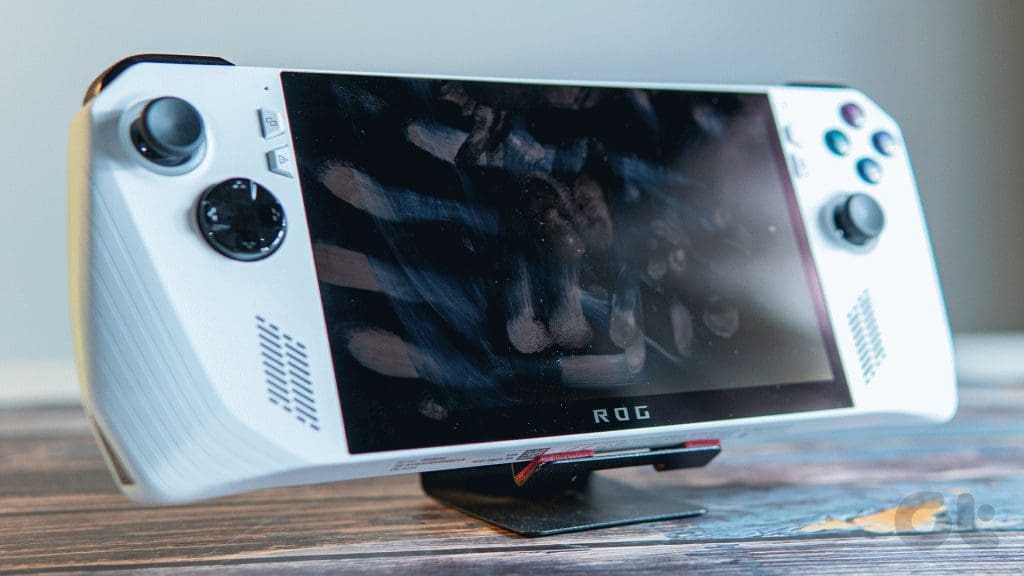
To the point where you constantly need to wipe the panel clean. This ends up being an issue, especially because this is a touch display, and the only practical way to interact with Windows OS is via touch. As such, this is another reason why I feel ASUS really should have included a touchpad somewhere on the body.
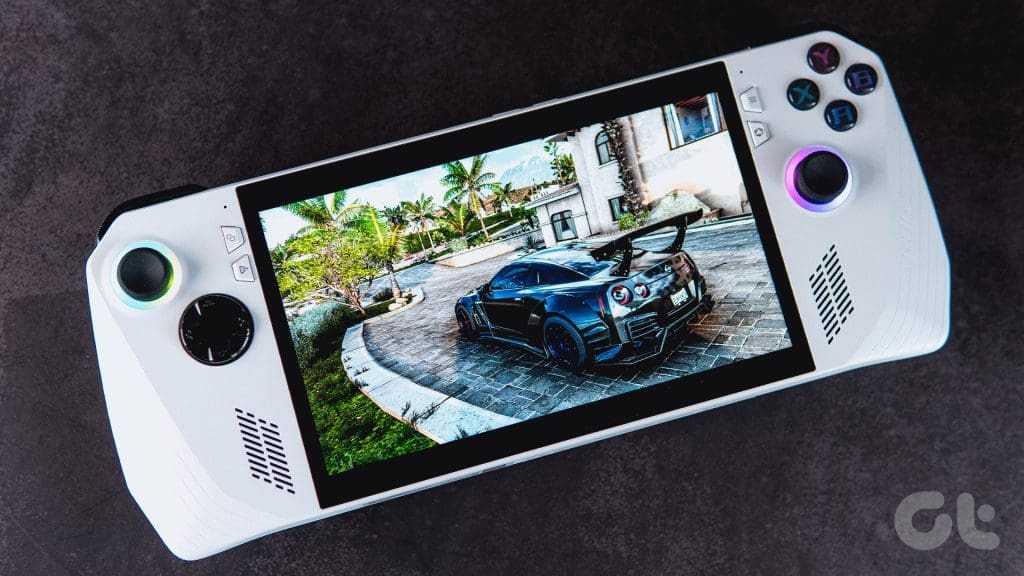
Apart from the fingerprints, there’s practically nothing wrong with the display here. It’s bright, vibrant, smooth, and super responsive.
Производительность
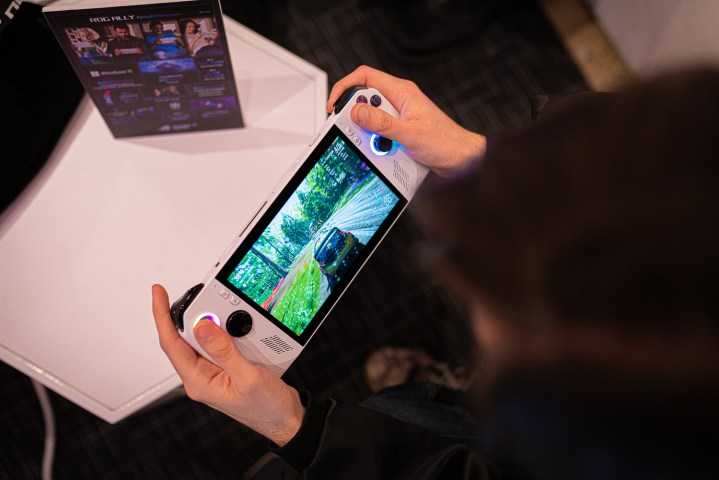 Джейкоб Роуч / Цифровые тенденции
Джейкоб Роуч / Цифровые тенденции
Когда Asus ROG Ally Z1 Extreme впервые был выпущен, он сразу же поразил своей превосходной производительностью. Z1 Extreme APU выбил Steam Deck из воды, и хотя ROG Ally не лишена некоторых проблем, на бумаге это лучшая консоль. Однако, у нас всегда было плохое предчувствие по поводу Z1 ROG Ally, и углубленное тестирование доказало, что мы были правы.
Эти два чипа, хотя и близки по названию, очень и очень далеки друг от друга с точки зрения своих возможностей. Это проблема в некоторых играх и приемлемая в других, но одно можно сказать наверняка: играть в самые требовательные игры AAA на Z1 ROG Ally будет в лучшем случае сложно, а в худшем – невозможно. Между тем, версия Z1 Extreme работает намного лучше.
Все сводится к тому, насколько способен APU, а характеристики Z1 Extreme гораздо лучше, чем у Z1. В то время как Ryzen Z1 оснащен только шестью ядрами процессора Zen 4, у Z1 Extreme их восемь. Два дополнительных ядра могут показаться не такими уж большими, но графический процессор в Z1 значительно слабее: он имеет только четыре ядра RDNA 3, в отличие от Z1 Extreme, у которого их 12.
Давайте посмотрим, как эти два чипа сравниваются в различных играх.
 Джейкоб Роуч / Цифровые тенденции
Джейкоб Роуч / Цифровые тенденции
Если Steam Deck отстает от Asus ROG Ally Z1 Extreme во всех тестах, а ROG Ally Z1 отстает от Steam Deck, то давайте будем честными — это не очень хорошо, и иногда это указывает на разницу между плавной работой и практически неиграбельностью. .
Мы протестировали обе консоли с разрешением 720p и энергопотреблением 15 Вт, что означает режим Performance. Модель Z1 в среднем выдавала всего 25 кадров в секунду (fps). Умирающий Свет 2, и это только на средних настройках, тогда как Z1 Extreme выдавал приемлемые 43 кадра в секунду. Менее требовательная игра, например Странная бригадапоказал лучшие результаты с 68 кадрами в секунду для Z1, но Z1 Extreme по-прежнему выигрывает со скоростью 20 кадров в секунду, составляя в среднем 88 кадров в секунду.
По всему нашему набору тестов Z1 примерно на 13% медленнее, чем Steam Deck, и на целых 29% медленнее, чем его брат, оснащенный Z1 Extreme. Хотя все приведенные выше оценки получены в режиме «Производительность», мы также протестировали Z1 во всех четырех режимах, и вот результаты.
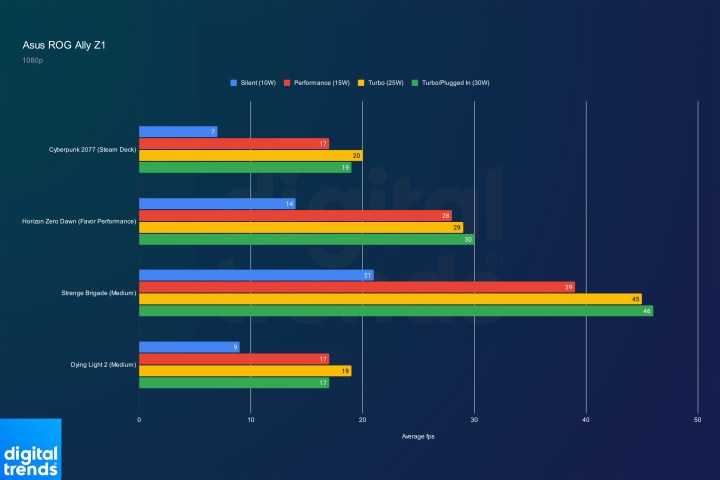 Джейкоб Роуч / Цифровые тенденции
Джейкоб Роуч / Цифровые тенденции
Вышеуказанные результаты получены при разрешении 1080p, и это само по себе весьма утомительно для Asus ROG Ally Z1. Неудивительно, что игра в Турбо с подключенным устройством дает наилучшие результаты, хотя и только Странная бригада и Горизонт: Ноль Рассвета в этом разрешении несколько плавные. Еще есть бесшумный режим, который в большинстве игр почти наверняка принесет больше разочарования, чем развлечения.
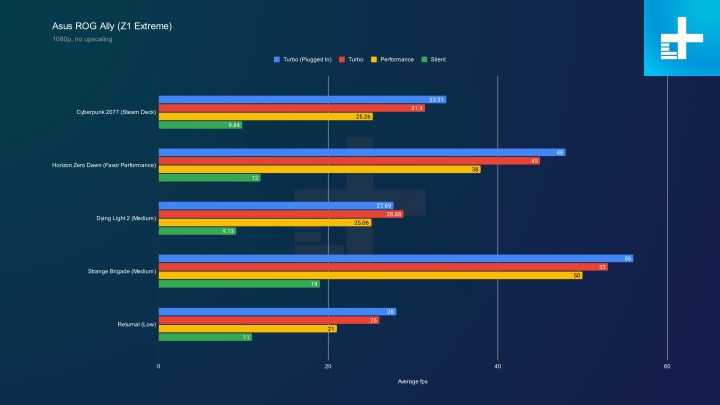 Джейкоб Роуч / Цифровые тенденции
Джейкоб Роуч / Цифровые тенденции
Вот аналогичный взгляд на ROG Ally с APU Z1 Extreme, но обратите внимание на цвета, поскольку они инвертированы. При разрешении 1080p портативный ПК смог обеспечить достойный игровой процесс в большинстве игр, хотя такие игры, как Возвратный доставляют больше хлопот, чем другие
Разрыв между включенным и отключенным режимом Turbo незначителен, но разница в частоте кадров в режиме Performance более заметна. В тихом режиме здесь тоже играть невозможно.
Сравнение этих двух наборов тестов показывает, что Z1 Extreme на 32% быстрее в режиме Turbo (от сети); На 28% быстрее в режиме Turbo 25 Вт; и на 27 % быстрее в режиме Performance. В бесшумном режиме оба устройства сопоставимы.
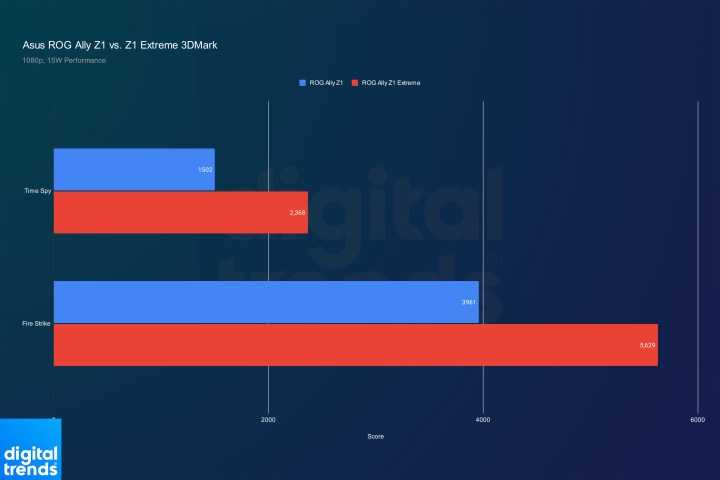 Джейкоб Роуч / Цифровые тенденции
Джейкоб Роуч / Цифровые тенденции
Мы протестировали обе версии ROG Ally в 3DMark Time Spy, и, к сожалению, эти оценки также не сулят ничего хорошего для нового портативного устройства. В режиме производительности по умолчанию ROG Ally Z1 отстает от Z1 Extreme на целых 37%. Тест Fire Strike прошел не намного лучше: чип Z1 оказался на 30% медленнее.
В целом, в каждом отдельном тесте, который мы провели, Z1 оказывается значительным шагом вперед по сравнению с Z1 Extreme. Хотя это не было неожиданностью, это все равно разительный контраст, особенно с учетом того, что Z1 ROG Ally стоит всего на 100 долларов дешевле.
Asus ROG Ally Z1 Extreme display
Asus ROG Ally Z1 Extreme is equipped with a IPS 7.0-inches display with a resolution of 1920 x 1080 pixels and 16:9 aspect ratio. This resolution, in my opinion, is excessive for a screen of 7.0 inches. Of course, you will be pleased with the highest clarity of the screen, and, undoubtedly, it is a pleasure to use such a device. However, there is a downside – increased energy consumption, which negatively affects battery life. If the endurance of the device is more important to you, I recommend taking a closer look at configurations with a lower display resolution, especially for a screen of this size.
Asus ROG Ally Z1 Extreme has a very fast screen with a frequency of 120 Hz. This is enough for both dynamic games and comfortable work. However, increased refresh rate and comfortable operation reduce the battery life of the device. In addition, few people are able to feel the difference between 90 Hz and 120 Hz, especially on a screen of this size.
The Asus ROG Ally Z1 Extreme display brightness averaged 450 nits. This is good for comfortable work indoors, perhaps outdoors on a cloudy day. In the bright sun, if I were you, I would not expect that you will be able to see anything on the screen.
Asus ROG Ally Z1 Extreme display contrast ratio is 1350:1 which is a great. The picture looks crisp and clear. It’s especially nice to watch movies on such a screen. The screen is glossy. Hit like button if you’re glossy screen fan! Subscribe to our channel if you prefer matte.
IPS displays have proven themselves very well in mobile devices, thanks to excellent viewing angles and good color reproduction at a low cost of production. Asus ROG Ally Z1 Extreme inherited the advantages of IPS panels, however, it was not without drawbacks.
Our colorimeter measurements showed 92% coverage of the color space sRGB. This is awesome, especially for games and movies, where the vivid colors is important. The gamma curve is noticeably smaller than the standard. Compared to reference displays, the Asus ROG Ally Z1 Extreme image looks flatter and lifeless. This can be an advantage in games where you want to highlight details in a dark environment, but for everyday tasks and especially photos and videos, this is more a disadvantage than an advantage. Within reasonable limits, this can be corrected by calibrating the display, but it is better to buy a screen with higher contrast ratio rather than trying to fix this one.
The white point is noticeably shifted to the cold area. For professional use, I would recommend calibrating the display. The color rendering “out of the box” is mediocre, and additional tuning is required if you plan to professionally work with photos or videos.
Software
So far, everything has mostly been positive about the ASUS ROG Ally. But it’s time for the biggest pro as well as the biggest con of this device. The Ally runs on Windows 11 Home. Without a doubt, Windows is just not optimized for touch displays, and navigating through Windows is a task. And the experience translates to the apps you use inside it as well.
The EA Play app just never scales properly, and good luck trying to open the keyboard while attempting to log in to it. Opening folders, searching through the Start menu, or even browsing on a web page for that matter isn’t that smooth.

With that being said, it’s clear that ASUS knows all about it. And they’ve done their fair share to fix it. Thanks to the Ally running Windows, it’s essentially a Windows laptop only. So when you want to use it as a laptop, just plug in a USB Dock/Hub and connect your keyboard and mouse. Or you can even use the XG Mobile, and output to a bigger display on your desk.
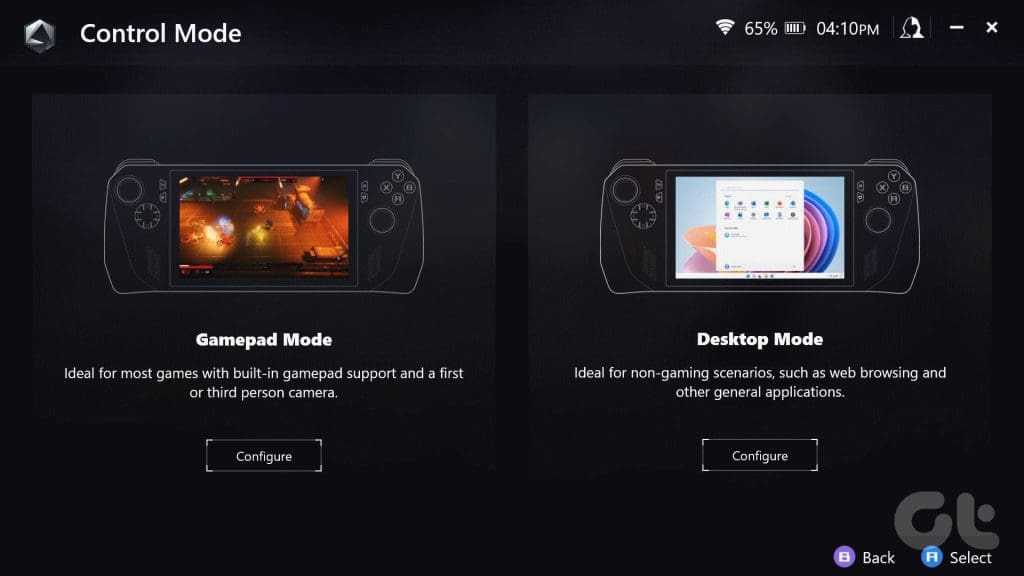
As for the handheld mode where you want to game, you don’t even need to rely on Windows. Well, at least not to launch the games. Once you’ve installed games inside using whatever store you wish to, the Armory Crate will automatically recognize the titles. You can seamlessly launch your games from the Crate itself.
What’s more, is that you don’t even have to use Windows once you’re done with installing your library of games. Just set the Armory Crate to launch at boot, and voila. You’ll be automatically taken to your games library without you having to interact with the unoptimized Windows 11.
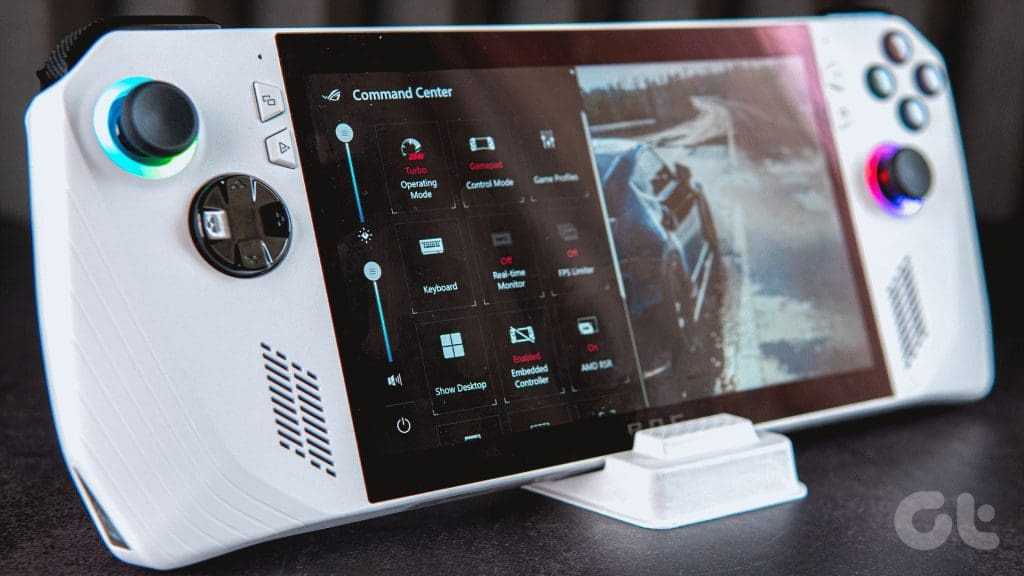
And it gets even better. The Command Center works as an overlay, which can be used for all your quick settings. So be it changing the TDP, adjusting the brightness, or even changing the resolution, you can do it all with ease. The Ally also allows you to easily capture screenshots as well as screen recording, and there’s a nice overlay to showcase the wattage and FPS meter too.
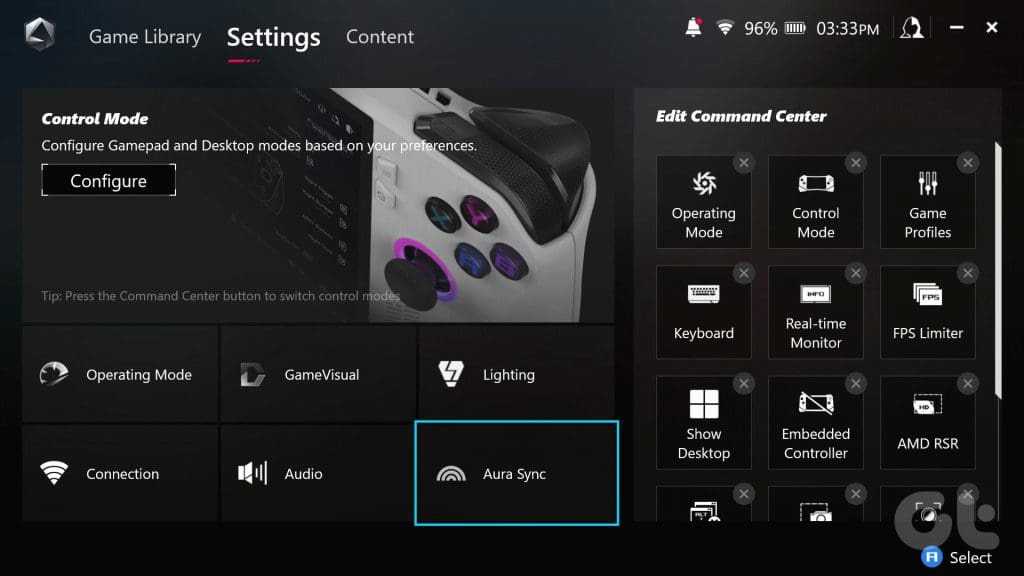
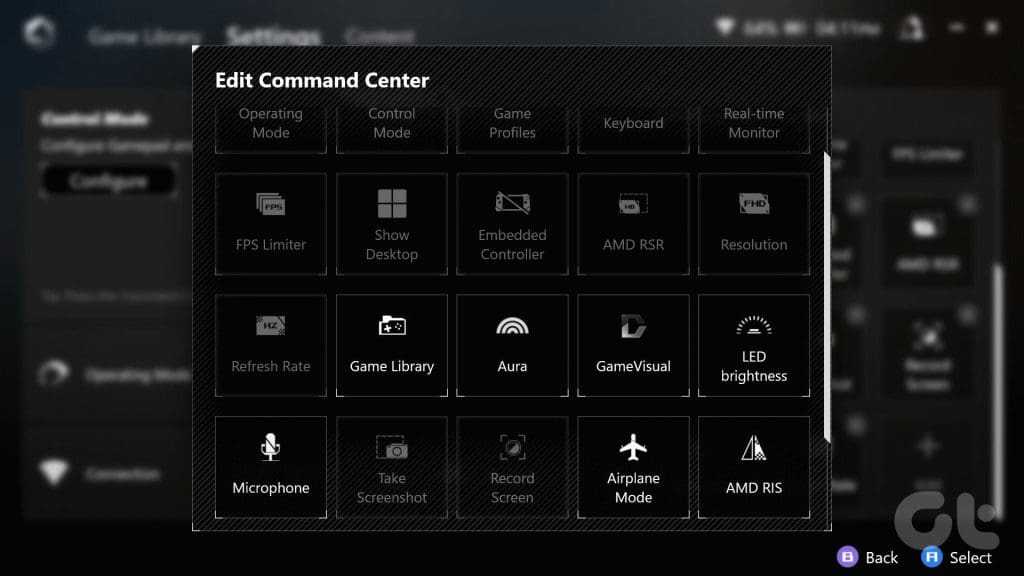
As for Windows itself, there’s talk of Microsoft working on a handheld version of Windows, which should theoretically make things better for the ROG Ally. But even without it, it’s only the initial setup that’s tough. When you want to use the Ally for work, just plug it into a dock and when you want to game, you don’t have to rely on Windows. So kudos to ASUS for doing a fantastic job here.
Gaming
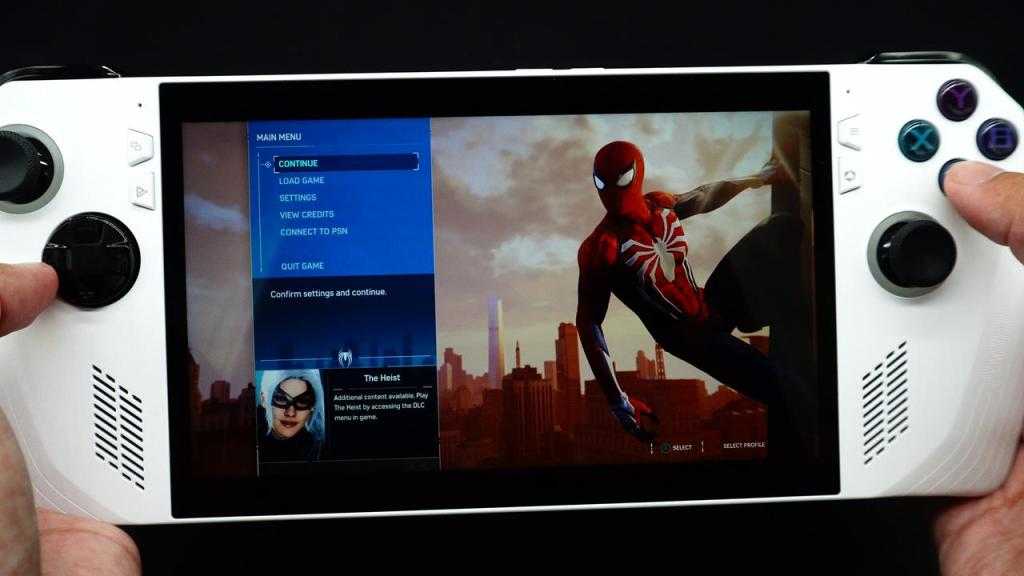
Now there’s a major caveat here. I had the ROG Ally in early May for two weeks and the firmware was basically overbaked. Yes, ASUS sent out review units across the world that weren’t ready to be reviewed properly, and as tech YouTuber Dave Lee (aka Dave2D) has explained, a recent firmware update that only works with the latest driver has resulted in 15-20% better performance. The good news is that the ROG Ally was already pushing out some great graphical performance even in this initial state, but with the software update? The gameplay footage you’re seeing throughout this review is going to look and run substantially better.
A quick further note as well: I’d stick to Turbo mode for games while charging, and performance mode while I was unhooked from the wall.
When it comes to raw numbers, the ROG Ally outperforms the Steam Deck by a massive margin. The AMD Ryzen Z1 Extreme APU is designed to deliver more pixel-rich gaming experiences while ensuring that frame rates do not suffer. Yes, the ROG Ally will beat the Steam Deck hands-down with better performance, although the results may vary.
The ROG Ally’s performance domination boils down to how you’ve got an individual game set up and which resolution you’re running with. Personally, I think you’ll be just fine with 720p, and that’s where the hardware shines. Not only is it still a sharp transmission of images, but at that resolution, you’re going to get a silky-smooth framerate as games regularly run brilliantly at 60fps. Dial up the resolution to 1080p and you’ll, on average, see demanding games run between 45-55 frames-per-second, with this effect becoming noticeable during more intense sequences.
But overall, I was really impressed with what I saw on the ROG Ally. I ran it through a gauntlet of games, ranging from emulators to more modern titles, and with games like Cyberpunk 2077, Marvel’s Spider-man, and Dirt 4 cranked up between medium and high graphical settings, it was astounding to see them run so well on such a compact device. I’m a sucker for older games as well, so playing old favorites like Batman: Arkham Knight and Wolfenstein: The New Order at a high graphical fidelity also put a smile on my face.
Of course there are exceptions to the rule, and some games flatout refused to work properly during my testing. I know it’s not fair to use it as an example, considering just how bad a state it’s in on this platform, but Star Wars Jedi: Survivor flatout refused to work on the ROG Ally and the Resident Evil 4 Remake demo was a stuttering mess. This is where Valve scores a few points for the Steam Deck, because at least with its verified program, you know exactly what will work on that system and what won’t, as compared to the install-and-see-for-yourself approach that the ROG Ally has.
This is where the Steam Deck reigns supreme, because if there’s one thing that the ROG Ally makes abundantly clear, it’s that Windows is probably the worst operating system to have on a handheld gaming system.
The heart of the Ally
Jacob Roach / Digital Trends
Let’s focus a bit more on the heart of the ROG Ally, though: the Ryzen Z1 Extreme APU. It comes with eight Zen 4 cores and 12 RDNA 3 graphics cores, with theoretical performance of 8.6 TFLOPs. For context, the PS5 has a theoretical performance of 10.3 TFLOPs.
You’re not getting PS5 levels of performance in the ROG Ally, but it’s a good illustration of the performance on tap. The main limiting factor is power. The Ryzen Z1 Extreme can operate in a range of 9 watts to 30W of sustained power (it can go higher for brief periods). That’s when you’re actually using the device, too. At idle, it can consume as little as 2W.
These power ranges are important because they are what determine the performance (and battery life) you’ll get out of the ROG Ally. Asus includes three modes in its Armoury Crate utility: Silent, Performance, and Turbo. These pull sustained power of 9W, 15W, and 25W respectively, and if you plug the device in at Turbo mode, it goes up to 30W.
A laptop, not a handheld
 Image used with permission by copyright holder
Image used with permission by copyright holder
First, it sits on top of Windows. When you boot up the ROG Ally, you’re met with a Windows lock screen, which you need to slide up and tap Sign In. Armoury Crate will attempt to load up right away, allowing you to navigate the device just with the controls on hand. It doesn’t always work, but Asus includes a dedicated button that will pull up or minimize Armoury Crate.
This is your hub, and it’s meant to emulate something like the gaming mode that SteamOS has. It hooks into every major PC platform — Steam, the Epic Games Store, the Xbox app, Ubisoft Connect, the EA App, and GOG Galaxy — and automatically populates your library with the games you have installed.
That’s only for games you have installed, though. Armoury Crate doesn’t allow you to manage your games in any way. You have to still use the desktop to install and uninstall games. The experience definitely isn’t as seamless as the Steam Deck. You’ll have to commonly minimize the Armoury Crate app to install games and do things like grab Windows updates.
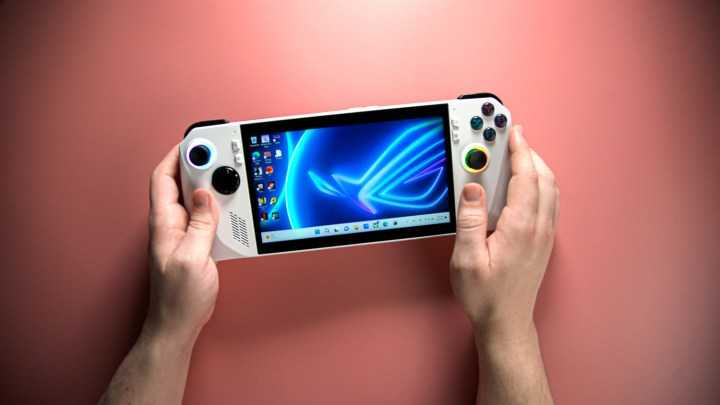 Jacob Roach / Digital Trends
Jacob Roach / Digital Trends
Asus makes an attempt to simplify the process. You can grab some updates from Armoury Crate itself, and apps like Steam are automatically configured to run in Big Picture mode. That doesn’t fully solve the problem, though.
Instead, I’d encourage you to set up a desktop controller configuration. Asus thankfully supports both a game configuration and a desktop configuration, which you can swap through the quick-access menu. All of the controls are re-bindable in Armoury Crate, which you can attach to mouse and keyboard commands, as well as common tasks like opening the Task Manager or closing the current window. Even better, every button can have a secondary function which you can activate with one of the back buttons.
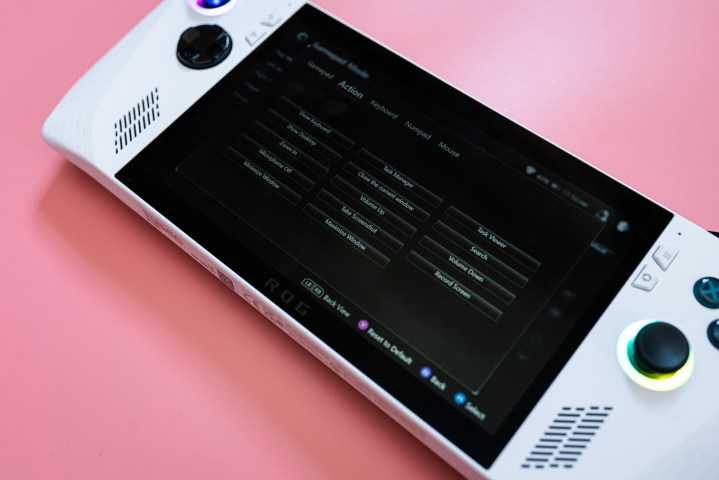 Jacob Roach / Digital Trends
Jacob Roach / Digital Trends
There’s a lot you can do, but I was still left wanting. There isn’t macro support for buttons, and you can’t use multiple keys at once. For example, Alt + Enter requires you to invoke the on-screen keyboard or bind each of those keystrokes to different buttons. This is something Asus can likely address in a software update, and I hope it does.
Thankfully, the desktop experience works. It’s not ideal, but the ROG Ally is much more responsive to touch inputs than the Steam Deck, and Windows itself is easy enough to get around. I was able to set up a couple of emulators, install external apps, and browse the internet on the ROG Ally free of peripherals. Small changes help a lot here, like the fact that tapping on an address bar automatically opens up the keyboard, and holding an icon invokes a right-click.
You can switch between the two controller modes through the quick access menu, which has its own dedicated button. This menu is fully customizable through Armoury Crate, so you can build your own loadout of settings to adjust refresh rate, limit your fps, pull up the real monitor, bring up the keyboard, and so much more. There’s a lot here already, and this is definitely an area where I could see Asus expanding with software updates in the future.
ASUS ROG Ally Z1 vs Z1 Extreme
Firstly, it’s worth noting there are many similarities between the two devices, especially when it comes to the exterior specs.
Both models boast a 7-inch Full HD (1920 x 1080) 16:9 IPS-level display, offering vibrant and sharp visuals, with a sRGB coverage of 100%. The display is protected by Gorilla Glass DXC and Gorilla Glass Victus, ensuring durability and resistance to scratches. They feature responsive touch screens with 10-point multi-touch capability. The display refresh rate for both is 120Hz, resulting in smooth motion transitions, with a quick 7ms response time which enhances the overall display performance. With a brightness of 500 nits, the screens deliver bright and clear visuals even in well-lit environments. Additionally, AMD FreeSync Premium technology is supported for both consoles, offering an improved gaming experience with reduced screen tearing and stuttering. Battery life varies according to games played.
Read on for some key differences – and a striking similarity.
Price
Here is where a key distinction lies. The Ally Z1 is currently set to retail for $599/£479.55. On the other hand, the Z1 Extreme version of the Ally is currently available for pre-orders from Best Buy for $699 USD/£559.61.
CPU and GPU
Another difference lies in the internal specs – CPU and GPU.
The Ally Z1 comes with an AMD Ryzen Z1 Processor is a high-performance CPU featuring the “Zen4” architecture on a 4nm process. It has 6 cores/12 threads, 22MB cache, and boosts up to 4.90 GHz. The GPU incorporates AMD Radeon Graphics (AMD RDNA 3) with 4 CUs, up to 2.5GHz, and 2.8 Teraflops. The processor operates at a TDP of 9-30W, offering a balance between power and efficiency.
On the other hand, the Ally Z1 Extreme comes with an even faster, more powerful set of kit. It boasts the AMD Ryzen Z1 Extreme Processor, which features advanced “Zen4” architecture on a 4nm process, with 8 cores/16 threads and a 24MB total cache. The CPU can boost up to 5.10 GHz, delivering fast and responsive performance. The GPU integrates AMD Radeon Graphics (AMD RDNA 3) with 12 CUs, up to 2.7 GHz, and a whopping 8.6 Teraflops. Despite its impressive specs, the processor maintains an energy-efficient TDP of 9-30W, making it suitable for various devices.
Memory
Here the two devices are equal. Both feature 16GB LPDDR5 on board, and 512GB PCIe 4.0 NVMeM.2 SSD. That’s more than enough to store all the games your heart desires.




























